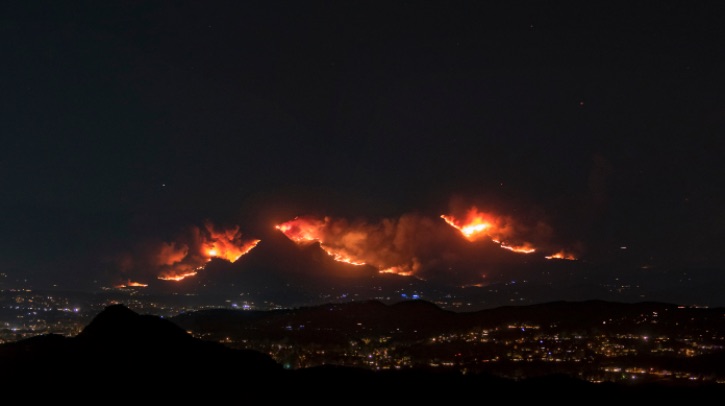According to AccuWeather’s research, extreme weather events and disasters in the past 12 months have had the costliest and most widespread impacts that Americans have faced in nearly a century.
The company’s revised preliminary estimate of the total damage and economic loss from the fast-moving, wind-driven infernos in Southern California stands between US$250bn and US$275bn. When combined with the nine additional weather disasters that AccuWeather issued preliminary estimates for in the past 12 months, the company estimates that the total damage and economic loss from extreme weather events over the past year has skyrocketed to between US$693bn and US$799bn. That figure is equivalent to nearly 3% of the United States annual gross domestic product.
“The catastrophic wildfires burning in Southern California, combined with destructive hurricane impacts last year, have been the worst series of natural disasters in America since the Dust Bowl in the 1930s,” AccuWeather founder and executive chairman Dr Joel N Myers said. “The Dust Bowl led to a massive migration west to California. Ninety years later, we expect these wildfires, the rising costs of rebuilding and recovery, the challenge of securing and affording insurance, as well as drought and water supply concerns, will likely lead to a significant migration out of California over the next few years.”
Why AccuWeather’s estimates are higher than others
AccuWeather’s preliminary estimate for the total damage and economic loss for the wildfires in Southern California is substantially higher than other estimates because many other organizations only focus on insured losses and direct losses.
The organization’s researchers considered the costs of immediate healthcare, long-term physical and mental healthcare, the financial impacts of excess deaths in the years following a disaster, and dozens of additional factors, to provide a more holistic and comprehensive scope of the long-term financial impacts.
“Damage estimates based only on insured losses and direct impacts grossly underestimate the long-term financial losses that families, businesses and communities endure after a weather disaster,” Myers explained. “There are many compounding factors that can multiply the financial impacts in the months and years after a disaster. Damage estimates that solely consider immediate and insured losses cannot truly capture the immense magnitude of a tragedy like this, especially in a high-risk area where some insurers are canceling policies and leaving thousands of people underinsured or uninsured.”
With thousands of multi-million-dollar properties destroyed in one of the most expensive real estate markets in the nation, Myers said impacts on property values and a loss of tax revenue will have major ramifications for the region’s economy.
“The destructive fires will likely erode the tax base, which could lead to a cutback in public services or higher taxes,” he noted. “This domino effect could worsen the migration out of California, as more families consider moving to states with lower taxes and a lower risk of wildfires.”
The company’s total damage and economic loss estimates also factor in cleanup costs, the value of home contents, damage to businesses, medical facilities, infrastructure and vehicles, as well as temporary wage losses and permanent job losses. AccuWeather total damage and economic loss estimates also account for the financial impact of power outages from utility damage and from planned public safety power shutoffs during wildfire threats, which can result in business disruptions and food spoilage affecting hundreds of thousands of people.
AccuWeather uses independent methods to evaluate all direct and indirect impacts of the storm, and a variety of sources, statistics and unique techniques to estimate the damage. It includes damage to property, job and wage losses, crops, infrastructure damage, interruption of the supply chain, auxiliary business losses and flight delays. The estimate also accounts for the costs of evacuations, relocations, emergency management and the extraordinary government expenses for cleanup operations and the long-term effects on business logistics, transportation and tourism. It also takes into account the health effects and the medical and other expenses of unreported deaths and injuries, plus the long tail of negative impacts to physical and mental health that survivors may face in the next decade.
Public health risks from smoke and rubble
“Unhealthy air and wildfire smoke can take a tremendous toll on public health, particularly for people who have emphysema, asthma and other respiratory and cardiovascular conditions,” Myers said. “Some of the buildings that burned have released asbestos, harmful chemicals and toxic fumes into the air. This is a major disaster with health impacts that will continue for months and years. We saw a similar and tragic outcome after the September 11 terrorist attacks in New York City. Many first responders were eventually diagnosed with lung cancer and other diseases after being exposed to toxic smoke and rubble. There have been hundreds, if not thousands, of premature deaths in the wake of the 9/11 attacks. I believe we may see a similar outcome when we look back at the impacts of these wildfires in five or 10 years.”
Not only did materials and components from burning homes, businesses, vehicles, electric car batteries, plastics and fuels send dangerous fumes and particulates into the air, but toxic elements may have also contaminated the soil and nearby waterways.
Myers also said that healthcare costs and insurance premiums in the region could rise in the wake of the wildfires. Access to and affordability of mental health services may also be strained.
In related news, AccuWeather’s research recently found that extreme weather events in the USA are becoming more frequent and economically impactful. Click here to read the full story.



